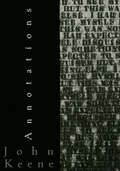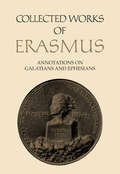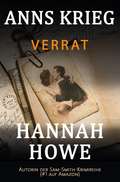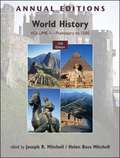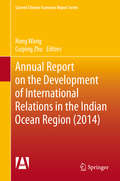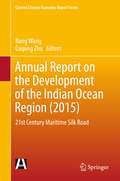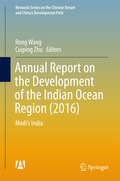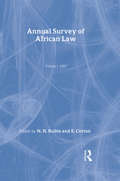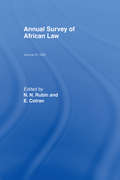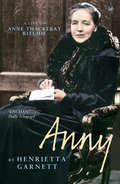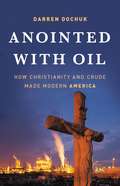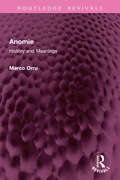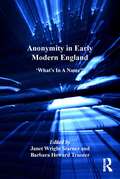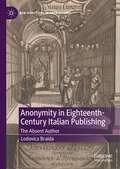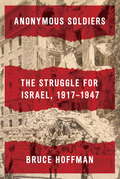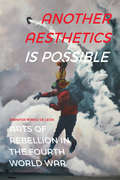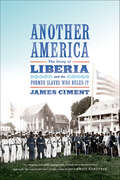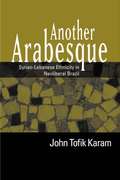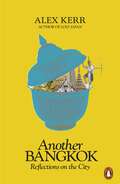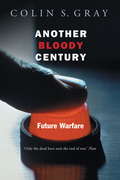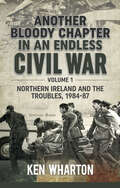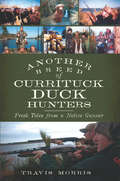- Table View
- List View
Annotations
by John Keene"Genius—brilliant, polished and of considerable depth." —Ishmael Reed An experimental first novel of poem-like compression, Annotations has a great deal to say about growing up Black in St. Louis. Reminiscent of Jean Toomer’s Cane, the book is in part a meditation on African-American autobiography. Keene explores questions of identity from many angles—from race to social class to sexuality (gay and straight). Employing all manner of textual play and rhythmic and rhetorical maneuvers, he (re)creates his life story as a jazz fugue-in-words.
Annotations
by John Keene"Genius—brilliant, polished and of considerable depth." —Ishmael Reed An experimental first novel of poem-like compression, Annotations has a great deal to say about growing up Black in St. Louis. Reminiscent of Jean Toomer’s Cane, the book is in part a meditation on African-American autobiography. Keene explores questions of identity from many angles––from race to social class to sexuality (gay and straight). Employing all manner of textual play and rhythmic and rhetorical maneuvers, he (re)creates his life story as a jazz fugue-in-words.
Annotations on Galatians and Ephesians
by Desiderius Erasmus Riemer FaberVolume 58 in the Collected Works of Erasmus series contains, for the first time, the English translation of Erasmus’ Annotations on Paul’s Epistles to the Galatians and Ephesians. Erasmus’ Annotations began as marginal comments in his own copy of the New Testament and were subsequently published in 1516 as a supplement to the Novum Instrumentum. His annotations were intended to justify his changes based on the Greek text. In each successive edition, published between 1516 and 1535, the Annotations grew in size and scope providing Erasmus with the opportunity to defend his translations in the face of growing criticism from orthodox Catholic theologians. This volume notes the editorial changes made in the five editions and also provides the reader with information about the patristic, medieval and contemporary sources consulted by Erasmus, and about the evolving relations with contemporary critics. The Annotations played a pivotal role in the development of sixteenth-century biblical exegesis and mark a significant stage in the evolution of humanist biblical scholarship.
Anns Krieg – Verrat
by Hannah HoweDie Krimireihe Anns Krieg Die Krimireihe Anns Krieg ist eine Reihe aus fünf Erzählungen, die in den Jahren 1944 bis 1945 spielen. Jede Geschichte ist circa 15.000 Wörter lang und beinhaltet einen in sich abgeschlossenen Fall. Die Geschichten sind: Betrayal (Verrat), Invasion (Invasion), Blackmail (Erpressung), Escape (Flucht) und Victory (Sieg). Der Handlungsbogen wird über die gesamte Reihe aufgebaut und findet seinen Abschluss im fünften Buch, Victory. Verrat Während ihr Mann auf einer streng geheimen Mission ist, macht sich Ann Morgan für einen weiteren Tag als Sekretärin in Trevor Bowmans Detektivbüro bereit. Aber dieser Tag wird alles andere als alltäglich werden. Innerhalb von 24 Stunden wird Anns Leben auf den Kopf gestellt, denn sie findet eine Leiche, trifft den gut aussehenden Witwer Detective Inspector Max Deveraux und stellt den Mörder in einer Geschichte voller Versuchungen und Lügen.
Annual Editions: Prehistory to 1500
by Helen Buss Mitchell Joseph R. MitchellThe Annual Editions series is designed to provide convenient, inexpensive access to a wide range of current articles from some of the most respected magazines, newspapers, and journals published today. Annual Editions are updated on a regular basis through a continuous monitoring of over 300 periodical sources. The articles selected are authored by prominent scholars, researchers, and commentators writing for a general audience.
Annual Report on the Development of International Relations in the Indian Ocean Region (Current Chinese Economic Report Series)
by Rong Wang Cuiping ZhuThis book focuses on international relations in the Indian Ocean region and examines bilateral and multilateral relations in the Indo-Pacific region. Written by leading researchers in the fields of international studies and Indian Ocean studies, the report provides a strategic review, major events and related data in this region. It is divided into three major parts: the General Report examines new characteristics in the relations between great powers, the strategic landscape of South Asia and the Indian Ocean region, and strategic competition and multilateral relations in the Indo-Pacific region. The second part explores current bilateral relations: India-Myanmar, Sino-Myanmar, Sino-India, US-Myanmar, and Japan-Myanmar, while the third highlights issues such as Myanmar's democratization, India and TPP. Despite the turmoil in this region, the report shows that it will predominantly be one characterized by peace, development and cooperation in the years to come. At the same time, it is vital that a new type of great power relations be established to ensure peace and prosperity in the Indian Ocean region. In closing, the report puts forward a number of suggestions for improving relations between China and Indian Ocean countries.
Annual Report on the Development of the Indian Ocean Region: 21st Century Maritime Silk Road (Current Chinese Economic Report Series)
by Rong Wang Cuiping ZhuThis report, written by senior scholars of international studies and Indian Ocean studies, focuses on international relations in the Indian Ocean region and covers many aspects of the 21st-Century Maritime Silk Road. The report covers strategic reviews, major events and related data in this region, as well as the origin and aims, frameworks and regional and global impacts of the 21st-Century Maritime Silk Road. The contributors hail from five prominent institutes in China. Together they provide the readers a comprehensive and authentic picture of the 21st-Century Maritime Silk Road. This year's Annual Report is the third in the series and the only one that focuses exclusively on the Indian Ocean region in China.
Annual Report on the Development of the Indian Ocean Region: Modi’s India (Research Series on the Chinese Dream and China’s Development Path)
by Rong Wang Cuiping ZhuThis book focuses on international relations in the Indian Ocean region and covers many policy aspects of Modi's India. Written by leading scholars of international and Indian Ocean studies, this annual report includes both a strategic review and the major events and related data in this region. It also discusses the origin, aims, frameworks and regional and global impact of India's development under the Modi administration, offering readers a full and authentic picture of the most recent developments in India. This year's Annual Report is the fourth of this kind and the only one to include the Indian Ocean region of China.
Annual Survey of African Law Cb: Volume One : 1967
by E. Cotran N. N. RubinThis is the first in a series of annual volumes which aim to review the principal legal developments that take place in the countries of sub-Saharan Africa. This series is intended to enable those who have an academic or professional interest in African law to keep abreast of changes in the various branches of the different legal systems of Africa.
Annual Survey of African Law Cb: Volume Three : 1969
by N. N. Rubin, E. CotranFirst published in 1973. Routledge is an imprint of Taylor & Francis, an informa company.
Annus Horribilis
by J. F. González EgidoEl camino más oscuro al que podía llevarle el amor. Elisabeth no llega a comprender por qué Adam, el viejo comerciante de Bristol que la crio y que ahora agoniza, se obceca en revelarle los pormenores de la muerte de sus padres. A través de manuscritos que se remontan a la fatídica fecha de 1666, que trajo a Inglaterra la guerra, la peste y el fuego de Londres; descubrirá cómo la vida de sus progenitores dio un vuelco al intentar entrometerse en el negocio de Christopher Harris, un bronco tratante de esclavos. Un viaje de amor e infortunio desde Bristol, boyante por el creciente tráfico de esclavos, hasta un decadente Londres amenazado por la sombra de la plaga.
Anny: A Life of Anny Thackeray Ritchie
by Henrietta GarnettAnne Thackeray Ritchie, daughter of the author of Vanity Fair and step-aunt of Virginia Woolf, was also a fine writer. Based on new and original research, this enchanting and evocative memoir paints the world of Anny's intricate web of relations and friends: children's parties with the Dickens family, holidays with Julia Margaret Cameron and the Tennysons, intimate scenes with Browning in Rome and Ruskin on Lake Coniston.In addition we read about Anny's own inner life: her near-obsession with her father: William Makepeace Thackeray, her escape into writing, her startling marriage to her second cousin and her godson, and the story of her sister Minny's passionate marriage to Leslie Stephen. We also learn of Stephen's second wife, Julia Jackson, mother of Vanessa Bell and Virginia Woolf. Meticulously researched, this intimate story draws not only on a wealth of letters, journals, hitherto unpublished sketches and photographs, but also on family legends passed down to the author through four generations. Illuminating, comic and touching, Anny reads like a novel, presenting a unique portrait of the rich literary world that formed the bridge between the Victorians and Bloomsbury.
Anointed with Oil: How Christianity and Crude Made Modern America
by Darren DochukA groundbreaking new history of the United States, showing how Christian faith and the pursuit of petroleum fueled America's rise to global power and shaped today's political clashesAnointed with Oil places religion and oil at the center of American history. As prize-winning historian Darren Dochuk reveals, from the earliest discovery of oil in America during the Civil War, citizens saw oil as the nation's special blessing and its peculiar burden, the source of its prophetic mission in the world. Over the century that followed and down to the present day, the oil industry's leaders and its ordinary workers together fundamentally transformed American religion, business, and politics -- boosting America's ascent as the preeminent global power, giving shape to modern evangelical Christianity, fueling the rise of the Republican Right, and setting the terms for today's political and environmental debates. Ranging from the Civil War to the present, from West Texas to Saudi Arabia to the Alberta Tar Sands, and from oil-patch boomtowns to the White House, this is a sweeping, magisterial book that transforms how we understand our nation's history.
Anomie: History and Meanings (Routledge Revivals)
by Marco OrruFirst published in 1987, Anomie examines essential moments of Western thought, tracing the complex concept of anomie. The Greek origin of the term (a-nomia, absence of joy) relates it to the notions of disorder, inequity and anarchy. 20th century sociology has long called into question an over simple dichotomy between law and the absence of law. The book shows that this questioning is not new. It has its roots in Ancient Greek thought and in the founding texts of the Judeo-Christian tradition. It appears in the legal and religious states of the English Renaissance, and in the emerging sociology of 19th century French, where Orrù opposes the collectivism of Durkheim to the individualism of Jean-Marie Guyau. The latter’s thought, little recognized at that time, finds an echo in contemporary sociology, notably in American sociologist R. K. Merton. To write the history of the concept, to account for the fluctuations in meaning that it undergoes in the changing prism of diverse societies, to uncover the subterranean continuities between yesterday and today: this is the aim of the book. This book will be of interest to students of history, sociology, literature and philosophy.
Anonymity in Early Modern England: 'What's In A Name?'
by Barbara Howard TraisterExpanding the scholarly conversation about anonymity in Renaissance England, this essay collection explores the phenomenon in all its variety of methods and genres as well as its complex relationship with its alter ego, attribution studies. Contributors address such questions as these: What were the consequences of publishing and reading anonymous texts for Renaissance writers and readers? What cultural constraints and subject positions made anonymous publication in print or manuscript a strategic choice? What are the possible responses to Renaissance anonymity in contemporary classrooms and scholarly debate? The volume opens with essays investigating particular texts-poetry, plays, and pamphlets-and the inflection each genre gives to the issue of anonymity. The collection then turns to consider more abstract consequences of anonymity: its function in destabilizing scholarly assumptions about authorship, its ethical ramifications, and its relationship to attribution studies.
Anonymity in Eighteenth-Century Italian Publishing: The Absent Author (New Directions in Book History)
by Lodovica BraidaThis book focuses on the different forms in which authorship came to be expressed in eighteenth-century Italian publishing. It analyses both the affirmation of the “author function”, and, above all, its paradoxical opposite: the use of anonymity, a centuries-old practice present everywhere in Europe but often neglected by scholarship. The reasons why authors chose to publish their works anonymously were manifold, including prudence, fear of censorship, modesty, fear of personal criticism, or simple divertissement. In many cases, it was an ethical choice, especially for ecclesiastics. The Italian case provides a key perspective on the study of anonymity in the European context, contributing to the analysis of an overlooked topic in academic studies.
Anonymous Soldiers
by Bruce HoffmanA landmark history, based on newly available documents, of the battles between Jews, Arabs, and the British that led to the creation of IsraelAnonymous Soldiers brilliantly re-creates the crucial period in the establishment of Israel, chronicling the three decades of growing anticolonial unrest that culminated in the end of British rule and the UN resolution to create two separate states. This groundbreaking book tells in riveting, previously unknown detail the story of how Britain, in the twilight of empire, struggled and ultimately failed to reconcile competing Arab and Jewish demands and uprisings. Bruce Hoffman, America's leading expert on terrorism, shines new light on the bombing of the King David Hotel, the assassination of Lord Moyne in Cairo, the leadership of Menachem Begin, the life and death of Abraham Stern, and much else. Above all, Hoffman shows exactly how the underdog "anonymous soldiers" of Irgun and Lehi defeated the British and set in motion the chain of events that resulted in the creation of the formidable nation-state of Israel. This is a towering accomplishment of research and narrative, and a book that is essential to anyone wishing to understand not just the origins of modern-day Israel or the current situation in the Middle East, but also the methodology of terrorism. Drawing on previously untapped archival resources in London, Washington, D.C., and Jerusalem, Bruce Hoffman has written one of the most detailed and sustained accounts of a terrorist and counterterrorist campaign that may ever have been seen, and in doing so has cast light on one of the most decisive world events in recent history. This will be the definitive account of the struggle for Israel for years to come.From the Hardcover edition.
Another Aesthetics Is Possible: Arts of Rebellion in the Fourth World War (Dissident Acts)
by Jennifer Ponce de LeónIn Another Aesthetics Is Possible Jennifer Ponce de León examines the roles that art can play in the collective labor of creating and defending another social reality. Focusing on artists and art collectives in Argentina, Mexico, and the United States, Ponce de León shows how experimental practices in the visual, literary, and performing arts have been influenced by and articulated with leftist movements and popular uprisings that have repudiated neoliberal capitalism and its violence. Whether enacting solidarity with Zapatista communities through an alternate reality game or using surrealist street theater to amplify the more radical strands of Argentina's human rights movement, these artists fuse their praxis with forms of political mobilization from direct-action tactics to economic resistance. Advancing an innovative transnational and transdisciplinary framework of analysis, Ponce de León proposes a materialist understanding of art and politics that brings to the fore the power of aesthetics to both compose and make visible a world beyond capitalism.
Another America: The Story of Liberia and the Former Slaves Who Ruled It
by James CimentThe first popular history of the former American slaves who founded, ruled, and lost Africa's first republicIn 1820, a group of about eighty African Americans reversed the course of history and sailed back to Africa, to a place they would name after liberty itself. They went under the banner of the American Colonization Society, a white philanthropic organization with a dual agenda: to rid America of its blacks, and to convert Africans to Christianity. The settlers staked out a beachhead; their numbers grew as more boats arrived; and after breaking free from their white overseers, they founded Liberia—Africa's first black republic—in 1847.James Ciment's Another America is the first full account of this dramatic experiment. With empathy and a sharp eye for human foibles, Ciment reveals that the Americo-Liberians struggled to live up to their high ideals. They wrote a stirring Declaration of Independence but re-created the social order of antebellum Dixie, with themselves as the master caste. Building plantations, holding elegant soirees, and exploiting and even helping enslave the native Liberians, the persecuted became the persecutors—until a lowly native sergeant murdered their president in 1980, ending 133 years of Americo rule.The rich cast of characters in Another America rivals that of any novel. We encounter Marcus Garvey, who coaxed his followers toward Liberia in the 1920s, and the rubber king Harvey Firestone, who built his empire on the backs of native Liberians. Among the Americoes themselves, we meet the brilliant intellectual Edward Blyden, one of the first black nationalists; the Baltimore-born explorer Benjamin Anderson, seeking a legendary city of gold in the Liberian hinterland; and President William Tubman, a descendant of Georgia slaves, whose economic policies brought Cadillacs to the streets of Monrovia, the Liberian capital. And then there are the natives, men like Joseph Samson, who was adopted by a prominent Americo family and later presided over the execution of his foster father during the 1980 coup. In making Liberia, the Americoes transplanted the virtues and vices of their country of birth. The inspiring and troubled history they created is, to a remarkable degree, the mirror image of our own.
Another Arabesque: Syrian-Lebanese Ethnicity in Neoliberal Brazil
by Karam John TofikOffering a novel approach to the study of ethnicity in the neoliberal market,Another Arabesqueis the first full-length book in English to focus on the estimated seven million Arabs in Brazil. With insights gained from interviews and fieldwork, John Tofik Karam examines how Brazilians of Syrian-Lebanese descent have gained greater visibility and prominence as the country has embraced its globalizing economy, particularly its relations with Arab Gulf nations. At the same time, he recounts how Syrian-Lebanese descendents have increasingly self-identified as "Arabs. " Karam demonstrates how Syrian-Lebanese ethnicity in Brazil has intensified through market liberalization, government transparency, and consumer diversification. Utilizing an ethnographic approach, he employs current social and business phenomena as springboards for investigation and discussion. Uncovering how Arabness appears in places far from the Middle East,Another Arabesquemakes a new and valuable contribution to the study of how identity is formed and shaped in the modern world.
Another Bangkok: Reflections on the City
by Alex KerrFrom the author of Another Kyoto and Lost Japan, a rich, personal exploration of the culture and history of Bangkok, and an essential guide for anyone visiting the cityAlex Kerr has spent over thirty years of his life living in Bangkok. As with his bestselling books on Japan, this evocative personal meditation explores the city's secret corners. Here is the huge, traffic-choked metropolis of concrete high-rises, slums and sky trains; but also a place of peace and grace. Looking afresh at everything from ceramics to Thai dance, flower patterns to old houses, Kerr reveals one of Asia's most kaleidoscopically complex cities. Another Bangkok will delight both those who think they know the city well and those visiting for the first time.
Another Bloody Century: Future Warfare
by Colin S. GrayHow the wars of the near future will be fought and who will win themMany nations, peoples and special interest groups believe that violence will advance their cause. Warfare has changed greatly since the Second World War; it continued to change during the late 20th century and this process is still accelerating. Political, technological, social and religious forces are shaping the future of warfare, but most western armed forces have yet to evolve significantly from the cold war era when they trained to resist a conventional invasion by the Warsaw Pact. America is now the only superpower, but its dominance is threatened by internal and external factors. The world's most hi-tech weaponry seems helpless in the face of determined guerrilla fighters not afraid to die for their beliefs.Professor Colin Gray has advised governments on both sides of the Atlantic and in ANOTHER BLOODY CENTURY, he reveals what sort of conflicts will affect our world in the years to come.
Another Bloody Century: Future Warfare
by Colin S. GrayHow the wars of the near future will be fought and who will win themMany nations, peoples and special interest groups believe that violence will advance their cause. Warfare has changed greatly since the Second World War; it continued to change during the late 20th century and this process is still accelerating. Political, technological, social and religious forces are shaping the future of warfare, but most western armed forces have yet to evolve significantly from the cold war era when they trained to resist a conventional invasion by the Warsaw Pact. America is now the only superpower, but its dominance is threatened by internal and external factors. The world's most hi-tech weaponry seems helpless in the face of determined guerrilla fighters not afraid to die for their beliefs.Professor Colin Gray has advised governments on both sides of the Atlantic and in ANOTHER BLOODY CENTURY, he reveals what sort of conflicts will affect our world in the years to come.
Another Bloody Chapter in an Endless Civil War: Northern Ireland and the Troubles, 1984–87
by Ken WhartonFour years of bloodshed in mid-1980s Northern Ireland, in the words of British soldiers who experienced it firsthand. Includes photos. Proceeding month-by-month from 1984 through 1987, this historical project provides a deep and detailed portrait of the British military experience in a period of frequent and unpredictable violence as the Provisional IRA grew in financial and logistical strength. As British Security Forces worked to contain the chaos, the Republican terror group fully embraced Danny Morrison&’s mantra— &“The Armalite and the ballot box&”—as they moved toward a realization that the British military could not be beaten, but that they could at least sit down with them from a position of strength. The goal was to keep up the pressure and force the British government to the bargaining table. But as the Provisionals and Loyalists fought, talked, and then fought again, a further 356 people died. Through oral histories, witness accounts, photos, and commentary, this book covers every major incident of the period, from the ambush of off-duty UDR soldier Robert Elliott to the bombing of Enniskillen. It also looks at the continued interference of the United States and the vast contribution of its citizens through NORAID, which ensured the killing and violence would continue. Lamenting brutality and the targeting of innocents regardless of the perpetrator&’s sympathies, veteran Ken Wharton, who has chronicled the Troubles extensively, reminds us of the universal threat, and horrifying toll, of terrorist tactics.
Another Breed of Currituck Duck Hunters: Fresh Tales from a Native Gunner (Sports History Ser.)
by Travis MorrisPeople called Currituck County a sportsman's paradise back when the skies clouded over with ducks and the waters teemed with fish. The game is more elusive these days and the hunting methods more sophisticated, but native Travis Morris shows through these stories that the thrill of it all is just as intense. From a four-year-old boy on his first hunt with his grandfather to an eighty-two-year-old woman who still loves to shoot her supper, Morris highlights both the heart and humor of the sportsman. There's a three-strand cord that will forever bind Currituck gunners: passion for the hunt, love of the outdoors and respect for the dangers of open, shallow waters.
